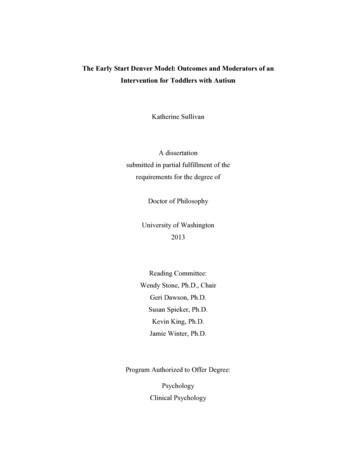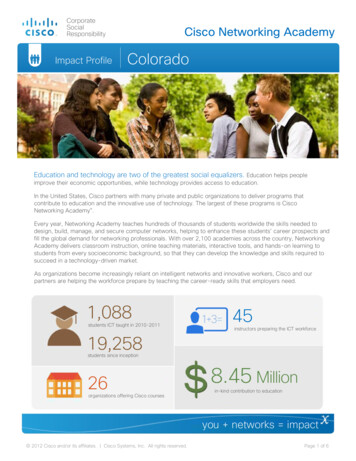
Transcription
The Early Start Denver Model: Outcomes and Moderators of anIntervention for Toddlers with AutismKatherine SullivanA dissertationsubmitted in partial fulfillment of therequirements for the degree ofDoctor of PhilosophyUniversity of Washington2013Reading Committee:Wendy Stone, Ph.D., ChairGeri Dawson, Ph.D.Susan Spieker, Ph.D.Kevin King, Ph.D.Jamie Winter, Ph.D.Program Authorized to Offer Degree:PsychologyClinical Psychology
Copyright 2013Katherine Sullivan
AbstractEffective treatment for young children with autism spectrum disorder (ASD) requiresidentification and development of effective treatments that address the unique needs of toddlerswith ASD as young as 18 months old. The current study aims to expand the current state of theresearch on the Early Start Denver Model (ESDM) as an effective intervention for toddlers withASD by examining both treatment outcomes as well as moderators of those outcomes. Threetreatment outcomes were examined, each relating closely to the conceptualization and goals ofthe ESDM and highlighting the anticipated relationship between general areas of developmentand specific behaviors: 1) shared positive affect, 2) gesture use, and 3) receptive and expressivelanguage). Moderators included initial levels of participant’s social orienting skills, response tojoint attention, and object use. The current study is a randomized, controlled trial that includedforty-eight children diagnosed with ASD between 18 and 30 months of age who were randomlyassigned to one of two groups: ESDM or referral to community providers for interventioncommonly available in the community. Results included main effects of ESDM treatment forcommunication outcomes, specifically receptive language (after 1 and 2 years of intervention)and expressive language (after 2 years of intervention). Additionally, significant moderation oftreatment effects was noted, particularly response to joint attention and object use moderatinglanguage outcomes and both high and low initial levels of object use moderating several childoutcomes. Continued focus on which children with ASD and their families benefit from ESDMintervention as well as identification of crucial treatment components will be critical for thedissemination and delivery of the ESDM beyond the research setting to the community at large.
Sullivan1I. OverviewGiven the development of better diagnostic tools and a greater level of professionalawareness and knowledge, autism spectrum disorders (ASD) can now be identified amongchildren ages two and younger (Chawarska, Klin, Paul, & Volkmar, 2007; Cox, Klein, Charman,Baird, Baron-Cohen, Swettenham, Drew, & Wheelright, 1999). Such advances in earlyidentification are essential for access to and implementation of early intervention and, as a result,better outcomes for children with ASD (Harris & Handleman, 2000; Smith & Dillenbeck, 2006).For example, Goldstein (2002) suggests that the prevalence of nonverbal children with ASD isdecreasing as early intervention becomes more accessible. While some researchers haveexamined variability in outcomes among children diagnosed as young as 30 months of age(Harris & Handleman, 2000; Landa, Holman, & Garrett-Mayer, 2007; Turner & Stone, 2007),there is a lack of published outcome data on intervention models or treatment effectiveness forchildren who begin intervention by or before 30 months. Recently, intervention approachestargeting toddlers with ASD have been developed (Chandler et al., 2002; Dawson et al., 2010;Green et al., 2002; Itzchak et al., 2008); however, a lack of published randomized studies oftoddler interventions exists. In addition, some teaching procedures that are consideredappropriate for older children (e.g., 40 hours per week of adult-directed treatment and repetitivedrill practice while sitting at a table) are considered developmentally inappropriate for toddlers.For these reasons, it is important to investigate the effectiveness of early intervention methodsthat are appropriately designed for toddlers with ASD (Wallace & Rogers, 2010).This dissertation is unique in that it is the first randomized controlled trial of earlyintervention with toddlers with ASD. Additionally, this paper addresses the need for informationregarding specific factors and individual characteristics that determine differential response tointervention in this population. In regards to examining treatment effectiveness, the current study
Sullivan2is unique both in its methodological rigor (i.e., longitudinal design including gold-standarddiagnostic criteria, randomized group assignment, evaluation by naïve examiners, and fidelitymonitoring for the implementation of a manualized intervention) and its target population (i.e.,children with ASD as young as 18 months old). Results have important implications for futureresearch related to the design, evaluation, and individualization of early intervention for toddlerswith ASD. Further, this project is the first of its kind to examine moderators of early interventionin young children with ASD over a two-year period.This paper first provides a brief overview of ASD including current diagnostic criteria aswell as issues related to prevalence and early diagnosis. Next, the literature pertaining to theearly core characteristics of ASD (i.e., reciprocal social behaviors and communication skills) isdiscussed. Then early intervention in ASD is reviewed, including two areas of research that mayhave important implications for treatment design and implementation, namely brain developmentand environmental influences on learning. Next, a summary of the ESDM intervention ispresented and a brief overview of the ESDM treatment goals and moderators are discussed.Finally, the methods and results are presented, followed by a discussion of the findings.II. Autism Spectrum Disorders: Brief DescriptionAutism Spectrum Disorders (ASD) is a term used to describe a group ofneurodevelopmental disorders including Autistic Disorder, Asperger’s Syndrome, and PervasiveDevelopmental Disorder-Not Otherwise Specified (PDD-NOS). ASD is estimated to occur at arate of approximately 1 in 88 (CDC, 2012), compared to prevalence reports in the 1960s and1970s estimating 5 in 10,000 (Newschaffer et al., 2007). The apparent increase in prevalence hasled to much public and scientific debate as to the possible causes. Some suggest that vaccinesand thimerosol, a mercury containing preservative in vaccines, may be responsible for the rising
Sullivan3rates of the disorder. However, to date, there has been no scientific evidence to support this link(Miller & Reynolds, 2009). Instead increased prevalence rates appear to be related to a numberof other factors including the broadening definition of ASD (particularly at the less severe end ofthe spectrum) and an increasing use of the diagnosis to receive federally mandated interventionprograms (Newschaffer et al., 2007; Rutter, 2005). Additionally, earlier identification anddiagnosis of ASD among children two years old and younger may help explain the increase inprevalence rates (Fombonne, 2009). Across the years, gender rations of ASD have remainedconsistent. ASD affects three to four males to every one female (4:1), and research indicates thatwhen females do have a diagnosis of ASD they tend to be more severely affected in terms ofcognitive impairments and severity of ASD symptoms (Fombonne et al., 1998).The current diagnostic criteria for ASD include impairments in three core areas offunctioning: reciprocal social interactions, communication skills, and restricted and/or repetitiveinterests and behaviors (DSM-IV-Text Revision; American Psychiatric Association, 2000). Theonset of these symptoms typically occurs before the age of three years old. Examples of socialdeficits in ASD include a lack of developmentally appropriate peer relationships, limitedpleasure in shared interactions, and difficulties with nonverbal interaction skills includinginconsistent eye contact and a limited range of facial expressions. In the area of communicationskills, individuals with ASD often demonstrate delays in language that are not compensated forby gesture use, difficulties with reciprocal conversation, stereotyped or idiosyncratic language,and limited imitative social play as well as impairments in functional and creative play. Finally,examples of repetitive behaviors and interests in ASD include intense or abnormal interests,insistence on adhering to routines or rituals, stereotyped or repetitive motor mannerisms (e.g.,hand flapping), and a preoccupation with parts of objects.
Sullivan4ASD is extremely heterogeneous in its presentation. The constellation of symptoms forany given individual can vary widely and is often influenced by chronological age anddevelopmental level. For example, epidemiological studies indicate that 65% of individualsdiagnosed with ASD have comorbid intellectual disability while the remainder have generalcognitive abilities in the average to above average range (Fombonne, 2003). Additional andnotable variability exists in the area of language abilities. While some individuals with ASD areverbally fluent and meet their language developmental milestones on time, 30-50% of childrenwith ASD are reported to have significant impairments in language and/or remain nonverbal intoadulthood (Howlin, Goode, Hutton, & Rutter, 2004). However, additional research suggests thatthe proportion of nonverbal children with ASD is less than 20% for those children who arereferred for evaluation of ASD at early ages (Lord et al., 2004), illustrating the importance ofearly detection and diagnosis.In the United States, the average age of diagnosis for ASD ranges from 3 years to 5 years,8 months depending on sample characteristics and geographical location (e.g., Autism andDevelopmental Disabilities Monitoring Network, 2009; Barbaro & Dissanayake, 2009; Mandellet al., 2010; Shattuck et al., 2009). Individual characteristics that may contribute to an earlierdiagnosis include being male, having an IQ score at or below 70, and having a history of adevelopmental regression (Shattuck et al., 2009). Despite an average age of diagnosis in thepreschool years, retrospective parent report often indicates that initial concerns arise by 15 to 18months of age (Howlin & Asgharian, 1999; Wiggins, Baio, & Rice, 2006) and studies of homevideotapes reveal that symptoms of ASD may be evident by 12 months of age (Adrien et al.,1991; 1992; Baranek, 1999; Osterling & Dawson, 1994; Werner et al., 2000). Additionally,prospective studies of high-risk infant siblings of individuals with ASD reveal new insights
Sullivan5about the identification and developmental time course of core symptoms of ASD (e.g.,Zwaigenbaum et al., 2005). Results from these studies will be critical in facilitating earlieridentification and diagnosis of ASD as well as providing key evidence for effective treatmentdesign and implementation. In the next section, the core characteristics of ASD will be discussedwith an emphasis on their respective developmental time courses.III. Early Core Characteristics of Autism Spectrum DisordersAs mentioned above, the current diagnostic criteria for ASD include impairments insocial interaction, communication, and repetitive or restricted behaviors or interests. Because thefocus of this review is on young children with ASD, an emphasis will be placed oncharacteristics in the domains of social interaction and communication, which are the mostprominent at young ages in this population (Bryson, Zwaigenbaum, & Roberts, 2004; Ozonoff etal., 2010; Stone et al., 1994). Areas of development within these two domains include socialreciprocity, play skills, gesture use, and receptive and expressive language, all of which arecomponents of the ESDM curriculum and are considered essential to the diagnostic assessmentfor ASD in children younger than 2 years old (Zwaigenbaum et al., 2009).A. Social Interaction and ReciprocitySocial impairment is an enduring feature of ASD with important implications for otherareas of development including gesture use, language acquisition, and adaptive functioning(Mundy et al., 1999; Sigman & Ruskin, 1999). Deficits in social skills have many manifestationsincluding limited shared attention, expression of positive affect, eye contact, reciprocal socialsmiling, social interest, social approach, and emotional responsiveness and imitation (Dawson &Adams, 1984; Dilavore et al., 1995; Greenspan & Wieder, 1997; Kasari, Sigman, & Yirmiya1993; Mundy et al., 1986; Travis & Sigman, 1998; Zwaigenbaum et al., 2004). In the following
Sullivan6sections, different areas of social development will be presented and reviewed in regards to bothtypical development and development in ASD.i. Social OrientingWithin the first six weeks of postnatal life, typically developing infants orient and attendto social stimuli, particularly toward people and their associated sounds, movements, and facialfeatures (Morton & Johnson, 1991; Rochat & Striano, 1999). Through attending and orienting tofaces, infants develop more sophisticated skills including the ability to turn their heads whentheir names are called (Rochat & Striano, 1999), and to discriminate among several facialexpressions as well as between familiar and unfamiliar faces (Barrera and Maurer, 1981; Blasi etal., 2011; Fantz, 1961; Goren et al., 1975; Johnson et al., 1991; Johnson & Morton, 1991; Oster,1981; Walker-Andrews, 1997; Young-Browne et al., 1977).Young children with ASD demonstrate deficits in spontaneously orienting to naturallyoccurring social stimuli in their environment. According to retrospective studies using homevideotapes, 8 to 12 month old infants later diagnosed with ASD were much less likely thantypically developing infants of the same age to orient to faces (Bernabei et al., 1998; Mars et al.,1998; Osterling & Dawson, 1994) and to their names (Baranek, 1999; Mars et al., 1998;Osterling & Dawson, 1994; Osterling et al., 2002; Werner et al., 2000). Additionally, Dawsonand colleagues (2004) showed that 3 to 4 year old children with ASD more frequently failed toorient to both non-social and social stimuli than did children with either development delays ortypical development of the same age, but impairments were more severe for social stimuli.Two major theories exist to account for the impairment in orienting to social stimuli inchildren with ASD. Some researchers suggest that ASD involves a general impairment inattentional functioning (Bryson et al., 1990; Courchesne et al., 1994; Dawson & Lewy, 1989a,
Sullivan71989b), which can contribute to an inability to rapidly shift attention between different stimuli(Courchesne et al., 1995), including complex and variable social stimuli (e.g., facial expressions,speech, gestures). Children with ASD may have difficulty attending to, processing, andrepresenting such unpredictable stimuli (Dawson, 1991; Dawson & Lewy, 1989a, 1989b;Gergely & Watson, 1999). Others suggest that children with ASD fail to assign reward value tosocial stimuli (Dawson et al. 2001; Mundy & Neal, 2001), which reflects a disturbance in themotivational mechanisms that normally draw an infant’s attention to social stimuli (Rochat &Striano, 1999).It has been argued that this failure to orient to social stimuli represents one of the earliestand most basic social impairments in children with ASD and, by depriving them of appropriatesocial stimulation, social orienting impairments may contribute to later-emerging social andcommunicative deficits, including the expression of shared affect (Dawson et al., 1998; Mundy& Neal, 2001).ii. Shared AffectAffective displays represent one of the earliest forms of social communication. Forexample, shortly after birth, newborns are capable of imitating adult facial expressions and therate of this facial imitation increases when adults tune into and follow the infants’ cues (Meltzoff& Moore, 1977). Such interactive reciprocity or synchrony between infants and caregivers iswell-established by the time an infant is 6 months old and is often characterized by shared affectin the form of mutual gazing, smiling, vocalizing, and physical touch (Field, 1990; Sigman et al.,2004; Stern, 1985; Stern et al., 1985; Tomasello et al., 2005). The majority of these sharedinteractions involve positive emotions (Malatesa & Haviland, 1982), making it not surprisingthat smiling is one of the earliest and most frequent social behaviors displayed by infants in the
Sullivan8first 6 months of life and is used to both initiate and maintain early social interactions (Bukatko& Daehler, 2001; van Beek et al., 1994; Kaye & Fogel, 1980; Venezia et al., 2004; Weinberg &Tronick; 1994; Yale et al., 2003).Infants later diagnosed with ASD, however, demonstrate reduced social smiling (Adrienet al., 1992; Cassel et al., 2007; Zwaigenbaum et al., 2005) and shared affect (Adrien et al.,1992) by 12 months of age. While these children are not void of emotional expression and, inparticular, positive affect, their use of affective expression during coordinated interactions or inresponse to the emotion of others is an area of deficit (Bieberich & Morgan, 1998; Greenspan &Wieder, 1997; Kasari et al., 1990; Loveland et al., 1994; Snow et al., 1987; Stone, 1997;Trevarthen & Daniel, 2005; Yirmiya et al., 2006). For example, Dawson and colleagues (1990)examined behaviors of children with ASD compared with typically developing children matchedon receptive language during face-to-face interactions with their mothers during a snackscenario. Children with ASD did not differ from the typically developing children in the numberof positive affect displays or the frequency of gazes at their mother’s face. However, significantdifferences were found in the reciprocal and interactional aspects of these episodes. Childrenwith ASD showed significantly less coordination of positive affect and gaze, and they weremuch less likely to respond to their mother’s smile than typically developing children (Dawsonet al., 1990).Differences in affect sharing also extend to negative emotions in children with ASD. In astudy by Corona and colleagues (1998), the emotional responsiveness of children with ASD wascompared to mental age-matched children with intellectual disability on measures of attention,behavioral reactions, facial affect, and cardiac response. The study involved a distress paradigmin which the experimenter pretended to hurt herself and displayed either neutral or distressed
Sullivan9affect. Both groups of children looked more at the experimenter’s face and displayed morenegative affect and concern in the distress situation than the neutral situation. However, thechildren with ASD looked at the experimenter’s face much less and did not exhibit a change inheart rate in either condition. These results were in contrast to the children with intellectualdisability who displayed both an orienting response and a decrease in heart rate during thedistress condition (Corona et al., 1998).The lack of reciprocal shared affect demonstrated by children with ASD could result incompensatory behaviors of parents or caregivers in order to elicit the coordination of affect andattention from their children (Lemanek et al., 1993). For example, when parents of children withASD interact with their children they may use more attention-getting behaviors, increase theirphysical proximity, or use more non-verbal prompts than parents of children with developmentaldelay, language delay, or typically developing children (Lemanek et al., 1993). Caregivers ofchildren with ASD may also exhibit a higher frequency of control strategies than other caregivers(Kasari et al., 1988; Sigman et al., 1986). Despite the method that a parent uses to get their childwith ASD’s attention and shared affect, researchers suggest that the amount of coordinationbetween the parent’s social bids and the child’s focused attention is not only key to elicitingshared affect, but may also longitudinally impact their child’s development of joint attention(Kasari, Sigman, Mundy, & Yirmiya, 1990; Mundy, Kasari, & Sigman, 1992; Vaughan et al.,2003) and language (Adamson & Bakeman, 1985; Dawson et al., 1990; Siller & Sigman, 2002).iii. Joint AttentionJoint attention skills are defined as the ability to “coordinate attention between interactivesocial partners with respect to objects or events in order to share an awareness of the objects orevents” (Mundy et al., 1986, p. 657). Joint attention differs from shared affect, described above,
Sullivan 10in that it refers to behaviors occurring within triadic interactions (i.e., coordinating attentionbetween a person and an object) rather than dyadic interactions (i.e., attention to a person only).Joint attention behaviors are also differentiated from other forms of triadic communication thatinvolve communication for purely instrumental purposes, namely requesting desired actions orobjects (Mundy et al., 2003). In typical development, infants begin to engage in joint attentionanywhere from 6 to 12 months of age (Carpenter et al., 1998; Corkum & Moore, 1998; Mundy &Crowson, 1997; Scaife & Bruner, 1975). Joint attention abilities include two separate behaviors:1) following the attention of another (e.g., following another’s eye gaze, head turn, or point),which is referred to as responding to joint attention (RJA; Mundy, Hogan, & Doehring, 1996;Seibert, Hogan, & Mundy, 1982); and 2) spontaneously initiating and/or directing coordinatedattention of another using eye gaze and/or gestures (e.g., pointing or showing), which is referredto as initiating joint attention (IJA; Mundy et al., 1996; Seibert et al., 1982).The attainment of joint attention skills is a critical milestone in early development and isimperative to social and language learning opportunities (Bakeman & Adamson, 1984; Baldwin,1995). In the first years of life, joint attention may involve overt aspects of visual attention, suchas showing a parent a toy. As a child ages, however, joint attention skills become more elaborateand involve subtle aspects of shared attention, such as ideas, intentions, and emotions (Mundy &Thorp, 2007; Rogers & Dawson, 2010). Additionally, several researchers examining jointattention in typically developing children have shown a relationship between joint attention skillsand development in the areas of language (Baldwin, 1995; Carpenter et al., 1998; Kwisthout etal., 2008; Morales et al., 2000; Mundy & Crowson, 1997), social skills (Vaughan Van Hecke etal., 2007), theory of mind (Tomasello, 1995), and even neural development (Kwisthout et al.,2008).
Sullivan 11Joint attention skills are often impaired in children with ASD (Mundy & Sigman, 1989).Between 10 to 11 months of age young children with ASD demonstrate emerging deficits in jointattention behaviors that persist into later childhood and beyond (Osterling, Dawson, & Munson2002; Presmanes et al., 2007; Swettenham et al., 1998; Young et al., 2003). RJA and IJA havedistinct developmental profiles and correlates in children with ASD. For example, as childrenwith ASD become older, IJA and RJA abilities appear to diverge. While RJA deficits mayemerge in the first year of life, by two years of age some children with ASD demonstrate basicgaze following ability (Chawarska, Klin, & Volkmar, 2003) and RJA abilities may continue toimprove in older children with ASD or for those with higher cognitive levels (Leekam et al.,2001; Mundy et al., 1994; Sigman & Ruskin, 1999). Impairments in IJA, however, appear topersist as children with ASD get older (Mundy et al., 1994; Sigman & Ruskin, 1999). Mundyand Thorp (2007) provide a neural explanation for this divergence of joint attention skills basedon the different areas of the brain involved in social initiation versus social response. Thespontaneous initiation of social attention and coordination that is characteristic of IJA mayrecruit executive and social-motivational processes more so than RJA behaviors, which typicallyinvolve responding to another person’s signal to shift attention (Mundy, 1995; Mundy et al.,2000). Interestingly, this developmental divergence in joint attention behaviors is also reflectedin the clinical measures used for diagnosing and screening ASD. For example, the AutismDiagnostic Observation Scale (ADOS; Lord et al., 1999) is considered the ‘gold standard’ forassessing and diagnosing ASD across ages, developmental levels, and language skills. Whenadministering the ADOS, the module used depends on the child’s expressive language level andchronological age. Module 1 is typically used for children who are nonverbal or whoinconsistently use phrase speech, and includes both IJA and RJA items in its diagnostic
Sullivan 12algorithm. Module 2, however, is used for children who use phrase speech, but are not verballyfluent, and includes only IJA in its diagnostic algorithm (Mundy & Thorp, 2007).Research examining the relationship between joint attention behaviors and otherdevelopmental constructs provides additional support for conceptualizing IJA and RJA asdistinct abilities. For example, IJA is more strongly related to individual differences in socialsymptom severity in preschool children with ASD than RJA (Mundy et al., 1994) and is morepredictive of a child’s tendency to spontaneously initiate social interactions seven to ten yearslater in life (Lord et al., 2003; Sigman & Ruskin, 1999). In contrast, RJA has been shown to bemore strongly related to concurrent and future receptive and expressive language abilities(Luyster et al., 2008; Murray et al., 2008; Paul et al., 2008; Schietecatte et al., 2011; Sigman &Ruskin, 1999; Tomasello & Todd, 1983), to predict change in socialization and daily living skillsas measured by the Vineland Adaptive Behavior Scales (Hutman et al., 2011), and to predictlater ASD diagnosis in 14 month old siblings of children with ASD (Sullivan et al., 2007). Dueto the relationship between RJA and these areas of development, all of which are included astargets of the intervention model examined for the current proposal (i.e., the ESDM), theremainder of the review on joint attention abilities will address RJA specifically in greater detail.As discussed above, RJA deficits in ASD start to appear in the first year of life asmeasured through behavioral observations of (Chawarska, Klin & Volkmar, 2003). At the neurallevel, the basic gaze-following behaviors of RJA may involve the “social brain” (Adolphs,2001), which is comprised of neural clusters in the temporal and parietal lobes and includes theamygdala, fusiform gyrus, prefrontal cortex, and superior temporal sulcus (Adolphs, 1999, 2001;2003; Brothers, 1990). Recently, Pelphrey and colleagues (2011) have proposed that ASDinvolves an early and initial failure to develop the specialized functions of one or more of the
Sullivan 13neuroanatomical structures that make up the “social brain,” one such function being socialinformation processing. Additionally, Mosconi and colleagues (2009) demonstrated arelationship between the amygdala and RJA abilities in 4-year-old children with ASD. Usingmagnetic resonance imaging, they reported that children with larger amygdala volumes hadincreased deficits in RJA abilities.From a social cognitive perspective, the development of RJA may be closely related tothe development of theory of mind and the ability to understand others’ feelings, thoughts, andintentions (Bretherton, 1991; Tomasello, 1995). In a recent study, Schietecatte and colleagues(2011) demonstrated that intention understanding uniquely contributed to RJA skills in 3-yearold children with ASD after controlling for the children’s respective IQ scores on the MullenScales of Early Learning (Mullen, 1995). Whether intention understanding is a prerequisite forRJA (Aldridge et al., 2000; Carpenter et al., 2001; d’Entremont & Yazbek, 2007) or activeengagement in RJA behaviors provides the experiential learning context to promote informationprocessing circuits involving intention understanding (Brooks & Meltzoff 2005; Yirmiya et al.,1998) is still a debate. Although imaging studies reveal that different cortical systems may beactivated for gaze following and the interpretation of intentions (Baron-Cohen et al., 1999;Mundy et al., 2000; Russell et al., 2000), Mundy and colleagues (2009) suggest that RJA andintention understanding develop concurrently and involve the integration of these two differentneural networks. Additional developmental studies suggest that gaze following may not initiallyreflect social-cognitive activity, but that it comes to do so over time (Brooks & Meltzoff, 2005;Moore, 1996; Woodward, 2003).Considering the behavioral, neural, and cognitive aspects of RJA as described above, it isimportant to understand the implications that impairments in this area may have on additional
Sullivan 14areas of development. For example, deficits in RJA may deprive children with ASDopportunities for social learning, thereby contributing to early social and language delays (e.g.,Sigman & Ruskin, 1999; Yoder et al., 2009). Researchers examining intervention for childrenwith ASD show promising results in ameliorating RJA deficits by promoting shared visualattention, a foundational skill on which social coordination and shared experiences with others isbuilt (Sullivan et al., 2007). Additionally, researchers studying RJA suggest that it is a highlyresponsive social behavior that may be relatively easy to influence through external stimuluscontingencies. For example, Leekam and colleagues (2001) demonstrated that gaze-followingskills improved in forty percent of participants (young children with ASD) when contingentexternal rewards were provided (i.e., illuminated targets appeared in response to correct gazeshifts). In another study of preschool-aged children with ASD receiving an interventionspecifically targeting RJA (Jones et al., 2006), results demo
Three treatment outcomes were examined, each relating closely to the conceptualization and goals of . verbally fluent and meet their language developmental milestones on time, 30-50% of children . 8 months depending on sample characteristics and geographical location (e.g., Autism and Developmental Disabilities Monitoring Network, 2009 .











